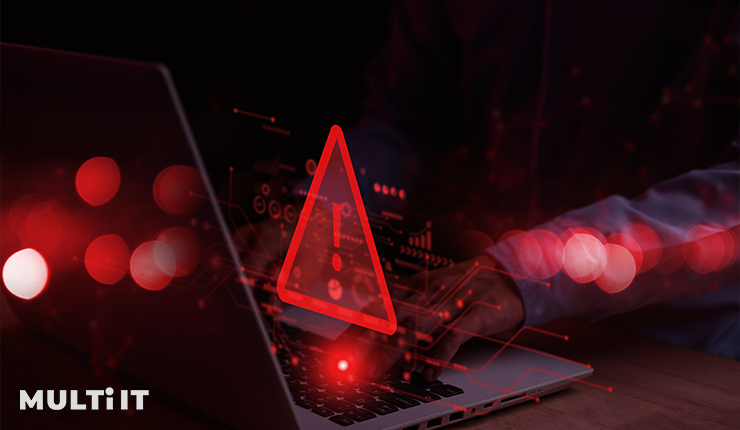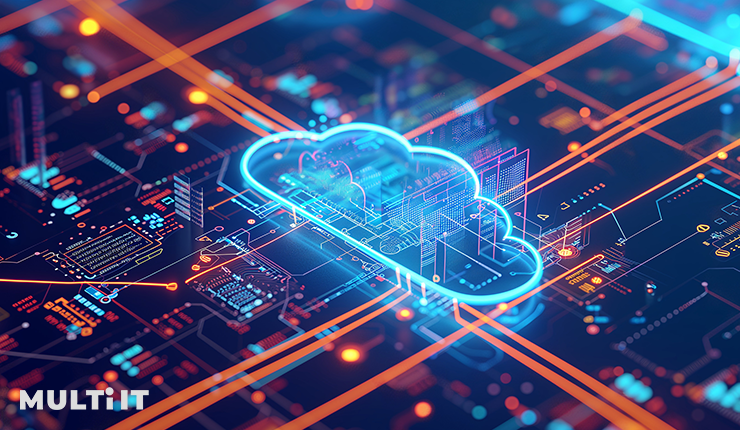

The Role of AI in Preventing Cyber Attacks
In a digital-first business landscape, cyber threats are evolving faster than ever. Traditional security systems, though still essential, are no longer enough to protect critical business assets. Enter Artificial Intelligence (AI): a transformative force reshaping how businesses detect, prevent, and respond to cyber attacks.
At Multi IT, we believe that staying ahead of threats requires more than just firewalls and antivirus software; it demands intelligent, adaptive systems capable of learning and evolving. AI-driven cybersecurity is no longer a future concept; it's a present necessity.
What Is AI in Cybersecurity?
AI in cybersecurity refers to the use of machine learning (ML), natural language processing (NLP), and other AI technologies to automate, accelerate, and enhance threat detection and prevention efforts.
Whereas traditional systems rely on static rule sets, AI-based tools continuously learn from historical data, behavioural patterns, and real-time activities to:
Detect anomalies
Predict attack vectors
Respond to threats autonomously
Reduce false positives
Why Traditional Cybersecurity Measures Are No Longer Enough
1. Increasing Threat Complexity
Cybercriminals are leveraging AI themselves to create more sophisticated malware, phishing campaigns, and deepfake attacks. Static security models can’t keep up with this rapid escalation.
2. Alert Fatigue
Security teams are often overwhelmed by thousands of alerts daily. Many of these are false positives, causing real threats to slip through unnoticed. AI can drastically reduce alert noise by prioritising the most critical risks.
3. Speed and Scale
Modern businesses generate massive volumes of data daily. Manual analysis simply can't scale. AI enables real-time monitoring and response across vast and complex digital environments.
How AI Prevents Cyber Attacks
1. Threat Detection Through Behavioural Analysis
AI systems can baseline "normal" user and network behaviour. When deviations occur, such as a user logging in from two countries simultaneously, AI can flag the activity as suspicious.
2. Real-Time Response to Threats
AI doesn’t just detect threats, it responds. With intelligent automation, AI can:
Isolate infected devices
Block malicious IPs
Disable compromised user accounts
All without human intervention.
3. Enhanced Email Security
Phishing remains the #1 vector for cyber attacks. AI-powered email security filters use NLP to detect tone, urgency, and anomalies in sender domains, spotting phishing attempts that bypass traditional filters.
4. Endpoint Protection
AI monitors every device on the network, PCs, mobile devices, and IoT endpoints for suspicious behaviour and zero-day exploits, often stopping malware before it executes.
5. Threat Intelligence Integration
AI can process vast amounts of threat intelligence from internal and external sources, giving organisations proactive defence capabilities based on emerging global attack patterns.
The Business Benefits of AI-Driven Cybersecurity
1. Reduced Risk Exposure
Faster threat detection means lower chances of data breaches, system outages, or reputational damage.
2. Cost Efficiency
Automated detection and response reduce the need for large, round-the-clock security teams and costly incident recovery processes.
3. Compliance Made Easier
Regulatory frameworks like POPIA and GDPR require rapid breach detection and response. AI systems help businesses stay compliant through real-time monitoring and automated reporting.
4. Scalability
As your business grows, so do your digital touchpoints. AI ensures that your security measures grow with you, without exponentially increasing resource demands.
Real-World Applications
Businesses across South Africa are already seeing tangible benefits from AI-based cybersecurity:
Finance: Detecting fraudulent transactions in milliseconds
Healthcare: Protecting patient data from ransomware
Retail: Blocking credential-stuffing attacks on e-commerce platforms
At Multi IT, our AI-powered cybersecurity solutions are designed to integrate seamlessly with your existing infrastructure, giving you robust protection without the complexity.
How Multi IT Helps You Harness the Power of AI
As a trusted Managed IT and cybersecurity partner, Multi IT provides tailored, AI-driven security solutions that:
Monitor your environment 24/7/365
Integrate with your existing software and cloud infrastructure
Adapt to your industry’s unique risk profile
Deliver actionable insights for continuous improvement
Our experts combine intelligent tools with human oversight, giving you the best of both worlds: machine precision and human intuition.
Final Thoughts
Cyber attacks aren’t just a possibility, they’re a guarantee. It’s not a matter of if, but when. With AI in your cybersecurity stack, you're not just reacting, you’re anticipating, adapting, and neutralising threats before they impact your business.
Ready to Protect Your Business Smarter?
Let Multi IT help you take a proactive, AI-powered approach to cybersecurity.
Contact us today to schedule a free security consultation.
VIEW MORE

5 Signs Your Business Is Vulnerable to a Cyber Attack
Cybercrime is no longer a distant risk; it's a daily reality for businesses of all sizes. In South Africa alone, cyber attacks are costing companies millions in data loss, downtime, and reputational damage. The worst part? Many businesses don’t even realise they’re vulnerable until it’s too late.
At Multi IT, we help businesses protect what matters most.
Here Are 5 Signs Your Business’s Cybersecurity Is At Risk
1. You Don’t Have a Formal Cybersecurity Policy
A lack of structure is a hacker’s dream. If your company doesn’t have a clear cybersecurity policy that employees follow, you’re inviting problems.
Red Flags:
No password complexity rules
No regular security training
No incident response plan
What to Do:
Implement a company-wide cybersecurity policy that covers access control, acceptable use, threat reporting, and breach response. Multi IT can help draft policies aligned to industry standards and compliance frameworks.
2. Your Systems Aren’t Regularly Updated
Outdated software, operating systems, and devices are common entry points for attackers. If your business skips updates or delays patching, you’re handing hackers the keys.
Real Risks:
Unpatched software vulnerabilities
Unsupported legacy systems
Delayed firmware updates on routers or firewalls
What to Do:
Set up automated updates and patch management. Multi IT offers proactive monitoring and maintenance, ensuring your IT environment stays secure and up to date.
3. You Have No Multi-Factor Authentication (MFA)
Still relying on passwords alone? That’s not enough. Weak, reused, or stolen passwords are a major cause of data breaches.
Stats to Know:
Over 80% of hacking-related breaches involve compromised credentials
MFA can block over 99% of automated attacks
What to Do:
Enable MFA for all critical systems, especially email, cloud services, and remote access. Multi IT helps businesses implement secure identity and access management that’s user-friendly and highly effective.
4. Your Employees Aren’t Trained to Spot Threats
Even with the best security tools, human error remains the biggest threat. Phishing emails, malicious downloads, and unsafe browsing habits put your business at constant risk.
Warning Signs:
No regular cybersecurity training
Employees clicking on suspicious links or attachments
Lack of awareness around common scams
What to Do:
Educate your staff through ongoing security awareness training. Multi IT offers customised employee cybersecurity programmes and simulated phishing tests to build stronger internal defences.
5. You Don’t Have a Backup or Recovery Plan
A cyber attack isn’t just about preventing access; it’s about surviving the worst-case scenario. Without reliable data backups and a disaster recovery plan, even a small breach can cripple your business.
Risks Include:
Ransomware that locks or encrypts your data
Accidental data deletion or loss
No way to restore operations after an attack
What to Do:
Adopt a business continuity strategy with cloud-based backups, versioning, and fast recovery tools. Multi IT provides secure, automated backup solutions with real-time recovery capabilities.
Final Thought: Prevention Is Cheaper Than Recovery
Cyber attacks are evolving. So should your defences. If your business shows any of the signs above, it’s time to take action before damage is done.
Multi IT’s cybersecurity solutions are built to detect, prevent, and respond to threats, combining smart automation with expert oversight.
VIEW MORE

How IT Compliance Can Protect Your Business from Cyber Threats
In an increasingly digital world, businesses of all sizes face a growing number of cyber threats. From phishing attacks to ransomware and data breaches, the risk landscape is complex and ever-evolving. At the same time, regulatory requirements for data security and IT compliance are becoming stricter. For South African businesses, achieving and maintaining IT compliance isn’t just about ticking boxes - it’s a critical layer of defence against cybercrime.
In this article, we unpack what IT compliance really means, how it intersects with cybersecurity, and why partnering with the right IT managed services provider - like Multi IT - can offer peace of mind, protection, and a proactive path to compliance.
What Is IT Compliance?
IT compliance refers to the process of meeting specific regulatory, industry, and internal requirements related to information technology systems, data handling, and security practices. These standards are designed to ensure that businesses:
Protect sensitive data
Mitigate security risks
Maintain operational continuity
Avoid legal and financial penalties
Common IT compliance standards include:
POPIA (Protection of Personal Information Act – South Africa)
GDPR (General Data Protection Regulation – EU)
ISO 27001 (Information Security Management)
PCI-DSS (Payment Card Industry Data Security Standard)
NIST (National Institute of Standards and Technology – USA)
Being compliant means your business meets the required guidelines for handling and securing data - especially personal and financial information.
Why IT Compliance Matters for Cybersecurity
While compliance is often viewed through a legal lens, it’s also a powerful tool for enhancing cybersecurity posture. Compliance frameworks generally require businesses to:
Encrypt sensitive data
Conduct regular security audits
Monitor systems for suspicious activity
Manage user access rights
Maintain incident response plans
These are also key cybersecurity best practices. Therefore, when a business aligns itself with IT compliance standards, it is inherently strengthening its defence against cyber threats.
Understanding Cyber Threats
Cyber threats are malicious acts that seek to damage, disrupt, or gain unauthorised access to computer systems, networks, or data. These threats can originate from a variety of sources, including hackers, insiders, nation-states, and even automated bots.
Common Types of Cyber Threats Include:
Phishing Attacks
Fraudulent emails or messages that trick users into revealing personal information or login credentials.
Ransomware
Malicious software that locks data or systems until a ransom is paid.
Malware
Includes viruses, worms, spyware, and Trojans that can compromise systems and data integrity.
Insider Threats
Employees or contractors misusing access privileges - either maliciously or accidentally.
Data Breaches
Incidents where sensitive, protected, or confidential data is accessed or disclosed without authorisation.
DDoS Attacks (Distributed Denial of Service)
Attempts to overwhelm a system, server, or network with traffic to crash or disable it.
Zero-Day Exploits
Attacks that occur on the same day a vulnerability is discovered - before a fix is available.
These threats can lead to financial loss, reputational damage, regulatory penalties, and business disruption, making proactive cybersecurity and compliance strategies non-negotiable.
How to Achieve IT Compliance
Achieving IT compliance is an ongoing process that requires strategic planning, execution, and maintenance. Here are the fundamental steps:
1. Identify Applicable Regulations
Understand which local or international compliance standards apply to your industry, data types, and operations.
2. Conduct a Gap Analysis
Assess your current IT and data protection practices against the required standards to identify weaknesses and areas for improvement.
3. Implement Security Policies and Controls
Develop and document policies that align with compliance requirements. This includes:
Access control
Encryption
Incident response
Data backup and recovery
4. Train Your Staff
Employees are often the weakest link in cybersecurity. Regular training ensures they understand compliance obligations and how to avoid risky behaviour.
5. Perform Regular Audits and Monitoring
Ongoing auditing and monitoring help detect vulnerabilities, ensure continued compliance, and prepare for regulatory reviews or breaches.
How Managed IT Services Providers Ensure Compliance & Cybersecurity
For many small to mid-sized businesses, maintaining IT compliance and staying ahead of cyber threats can be overwhelming without expert help. That’s where a Managed IT Services Provider (MSP) like Multi IT becomes indispensable.
Here’s How Multi IT Helps Safeguard Your Business:
Compliance-Driven IT Strategy
We align your IT infrastructure with compliance requirements relevant to your business and industry - ensuring you're protected and audit-ready at all times.
24/7 Threat Monitoring & Response
Our Security Operations Centre (SOC) actively monitors for suspicious activity and implements immediate response protocols in the event of a threat.
Data Backup & Disaster Recovery
Multi IT ensures your data is encrypted, regularly backed up, and recoverable in the event of a breach or failure - minimising downtime and data loss.
Policy & Documentation Support
We help you develop and maintain the necessary documentation - from Acceptable Use Policies to Disaster Recovery Plans - to stay compliant.
Security Awareness Training
We offer ongoing training for your staff, reducing the likelihood of human error and empowering your team to be the first line of defence.
Proactive Patching & System Updates
We ensure your systems are always up to date with the latest security patches - closing gaps before cybercriminals can exploit them.
Access Control & Identity Management
Our solutions help you manage who has access to what - and when - through multi-factor authentication, role-based access, and more.
Conclusion: Compliance is Your Cybersecurity Advantage
IT compliance is not just a regulatory checkbox, it’s a proactive strategy that fortifies your business against an increasingly complex and dangerous cyber landscape. By aligning your business with compliance standards and leveraging the expertise of a trusted Managed IT Services Provider like Multi IT, you don’t just reduce risk - you enable resilience, continuity, and confidence.
Need help ensuring your business is compliant and secure? Contact Multi IT today for an IT compliance consultation and gap analysis.
VIEW MORE

Optimising Your IT Infrastructure with Cloud Computing
In today’s fast-paced digital landscape, cloud computing has emerged as a vital component of modern IT infrastructure. Businesses across industries are leveraging cloud services to enhance efficiency, scalability, and security while reducing operational costs. Whether it is migrating legacy systems to the cloud, implementing security best practices, or managing costs effectively, organisations must strategically approach cloud adoption to maximise its benefits.
This article explores the different types of cloud services, provides a step-by-step guide to cloud migration, outlines best practices for cloud security, discusses cost management strategies, and examines the role of cloud computing in disaster recovery.
Understanding Cloud Computing and Its Benefits
Cloud computing refers to the delivery of computing services—including servers, storage, databases, networking, software, and analytics—over the internet. Instead of relying on on-premises hardware, businesses can leverage cloud infrastructure to improve flexibility, streamline operations, and scale as needed.
Key Benefits of Cloud Computing
Scalability: Easily scale resources up or down based on demand.
Cost-Efficiency: Reduce capital expenditure on hardware and maintenance.
Accessibility: Enable remote work and collaboration with cloud-based tools.
Security: Benefit from robust security protocols and compliance standards.
Disaster Recovery: Minimise downtime with cloud-based backup and recovery solutions.
Different Types of Cloud Services: IaaS, PaaS, SaaS
Cloud computing services can be categorised into three primary models, each catering to different business needs.
1. Infrastructure as a Service (IaaS)
IaaS provides virtualised computing resources over the internet, allowing businesses to rent servers, storage, and networking on a pay-as-you-go basis. This eliminates the need for costly on-premises infrastructure.
Use Case: Hosting websites, running enterprise applications, data storage.
Examples: Amazon Web Services (AWS), Microsoft Azure, Google Cloud Platform.
2. Platform as a Service (PaaS)
PaaS offers a development and deployment environment in the cloud, providing the tools and frameworks needed to build applications without managing underlying infrastructure.
Use Case: Software development, testing, and deployment.
Examples: Google App Engine, Microsoft Azure App Services, Heroku.
3. Software as a Service (SaaS)
SaaS delivers cloud-based applications accessible through a web browser, eliminating the need for installation or maintenance.
Use Case: Customer Relationship Management (CRM), email services, collaboration tools.
Examples: Microsoft 365, Salesforce, Dropbox.
Migrating to the Cloud: A Step-by-Step Guide
Cloud migration involves transferring digital assets, applications, and services from on-premises infrastructure to the cloud. A well-structured migration strategy ensures minimal disruption and maximises efficiency.
Step 1: Assess Business Needs
Identify workloads and applications suitable for migration.
Evaluate performance, compliance, and security requirements.
Step 2: Choose the Right Cloud Model
Public Cloud – Hosted by third-party providers, offering scalability and cost efficiency.
Private Cloud – Dedicated to a single organisation for enhanced security.
Hybrid Cloud – A combination of public and private clouds for flexibility.
Step 3: Develop a Migration Strategy
Rehost (Lift and Shift): Move applications without modification
Refactor: Modify applications to optimise cloud performance.
Rebuild: Redesign applications to fully leverage cloud-native capabilities.
Step 4: Execute Migration and Testing
Migrate workloads in phases to minimise disruptions.
Conduct rigorous testing to ensure performance, security, and compliance.
Step 5: Optimise and Monitor
Implement cloud monitoring tools to track usage and performance.
Continuously optimise resources to enhance efficiency and reduce costs.
Cloud Security: Best Practices for Protecting Data
While cloud computing offers robust security features, businesses must adopt proactive measures to safeguard sensitive data.
1. Implement Strong Access Controls
Use multi-factor authentication (MFA) to secure access, and restrict user permissions based on roles and responsibilities.
2. Encrypt Data
Encrypt data in transit and at rest to prevent unauthorised access, and utilise cloud-native encryption tools to enhance security.
3. Regular Security Audits and Compliance
Conduct periodic security assessments to identify vulnerabilities, and ensure compliance with industry regulations such as GDPR, HIPAA, and ISO 27001.
4. Enable Continuous Monitoring
Use Security Information and Event Management (SIEM) tools to detect anomalies.
Implement real-time alerts for potential security breaches.
5. Establish a Disaster Recovery Plan
Maintain regular backups in geographically dispersed cloud regions, and develop a rapid recovery strategy to minimise downtime.
Cost Management in Cloud Computing
Cloud computing can significantly reduce IT costs, but businesses must implement cost management strategies to prevent overspending.
1. Use Reserved and Spot Instances
Opt for reserved instances for predictable workloads to reduce costs. Then use spot instances for short-term computing needs at lower rates.
2. Implement Auto-Scaling
Configure auto-scaling to adjust resource allocation based on demand, and prevent unnecessary resource consumption during low-traffic periods.
3. Monitor and Optimise Usage
Use cloud cost management tools to track spending, optimise budgets, identify underutilised resources, and eliminate redundancies.
4. Adopt a Cloud Cost Governance Framework
Establish policies for cloud resource allocation and cost tracking, and educate teams on cost-efficient cloud usage practices.
Leveraging Cloud for Disaster Recovery
Disaster recovery (DR) is a critical component of business continuity planning, and cloud computing provides a reliable and cost-effective solution for minimising downtime.
Key Advantages of Cloud-Based Disaster Recovery
Automated Backups: Regular data backups ensure quick recovery in case of disruptions.
Geographic Redundancy: Cloud providers store data in multiple locations to prevent data loss.
Rapid Scalability: Instantly scale resources to handle increased demand during recovery.
Best Practices for Cloud Disaster Recovery
Conduct Risk Assessments: Identify potential threats and vulnerabilities.
Implement Backup Policies: Use incremental backups to reduce data loss.
Test Disaster Recovery Plans: Regularly simulate recovery scenarios to ensure effectiveness.
Embracing Cloud Computing for Future Growth
Cloud computing has revolutionised IT infrastructure, offering unparalleled scalability, security, and cost efficiency. By understanding the different types of cloud services, adopting a structured migration strategy, implementing security best practices, and managing costs effectively, businesses can fully leverage the power of the cloud.
Moreover, cloud-based disaster recovery solutions provide resilience against unexpected disruptions, ensuring business continuity. As organisations navigate the digital transformation journey, a strategic approach to cloud adoption will be key to optimising IT infrastructure and driving future success.
VIEW MORE

Enhancing Retail and E-Commerce Efficiency with Managed IT Services
In the competitive world of retail and e-commerce, operational efficiency is vital for success. From seamless IT systems to robust security and optimised workflows, businesses need the right tools and support to meet customer expectations, reduce costs, and scale effectively. Managed IT services play a critical role in achieving these objectives by providing tailored solutions for the unique challenges faced by the retail industry.
How Do Managed IT Services Improve Retail and E-Commerce Operations?
Managed IT services streamline technology management, offering expert support, proactive maintenance, and innovative tools designed to enhance performance. Here are the key benefits for retail and e-commerce businesses:
Improved Customer Experience: Reliable e-commerce platforms and fast, secure transactions help build customer trust and loyalty.
Minimised Downtime: Proactive monitoring and rapid issue resolution keep systems running smoothly, even during peak periods.
Scalability: Managed IT services provide the flexibility to adjust IT systems for seasonal demand or long-term growth.
By partnering with a managed IT provider, retail businesses can focus on growing their brand while ensuring seamless operations.
What is Workflow Automation in Retail?
Workflow automation uses technology to streamline repetitive tasks, improving efficiency and accuracy across business operations.
Examples of Workflow Automation in Retail
Order Processing: Automating fulfilment ensures accurate and timely deliveries, enhancing customer satisfaction.
Inventory Management: Real-time stock updates reduce the risk of overstock or stockouts.
Customer Engagement: Personalised email campaigns and automated responses improve customer interactions and loyalty.
By integrating workflow automation, retail businesses can save time, reduce errors, and optimise employee productivity.
What is Performance Monitoring in Retail IT?
Performance monitoring tracks IT systems, applications, and networks to ensure they function optimally, especially during high-traffic events.
Key Benefits of Performance Monitoring
Real-Time Tracking: Monitor e-commerce platforms, point-of-sale (POS) systems, and payment gateways to prevent disruptions.
Proactive Issue Resolution: Address potential issues before they impact customer transactions.
Data-Driven Insights: Analyse metrics to optimise website speed, application performance, and system reliability.
Performance monitoring ensures retail businesses provide a seamless shopping experience for customers, both online and in-store.
How Are Resources Optimised in Retail?
Resource optimisation involves using IT infrastructure, hardware, and software effectively to maximise return on investment.
Strategies for Resource Optimisation
Scalable Solutions: Cloud solutions adapt to seasonal demand spikes like Black Friday or holiday sales.
Centralised Management: Integrate POS systems, inventory databases, and CRM tools for streamlined operations.
Cost Reduction: Reallocate underutilised assets to improve efficiency and reduce expenses.
Optimised resources enable retail businesses to achieve cost savings while maintaining agility and responsiveness.
What is Proactive Maintenance in Retail IT?
Proactive maintenance involves regular inspections, updates, and repairs of IT systems to prevent unexpected disruptions.
Benefits of Proactive Maintenance
Reduced Downtime: Scheduled maintenance ensures systems are operational during peak periods.
Enhanced Security: Regular updates protect sensitive customer and transaction data from cyber threats.
Extended IT Lifespan: Preventative care reduces the need for costly replacements, saving businesses time and money.
Proactive maintenance ensures retail IT infrastructure is stable, secure, and ready to support operational demands.
Driving Retail and E-Commerce Success with Managed IT Services
In the fast-paced retail and e-commerce industry, efficiency and reliability are paramount. Managed IT services offer the tools and expertise to automate workflows, monitor performance, optimise resources, and maintain systems proactively. These services empower businesses to focus on growth and delivering exceptional customer experiences.
Partnering with Multi IT & Telephony Solutions ensures retail and e-commerce businesses have a robust, scalable IT infrastructure that aligns with their strategic objectives, driving long-term success.
VIEW MORE

Integrated IT Services
How Multi IT & Telephony Solutions Ensures Seamless Operations
In today's fast-paced digital environment, businesses depend on the continuous performance of their IT infrastructure. Fragmented systems and disconnected services can create costly delays, security vulnerabilities, and communication breakdowns. Integrated IT services are essential to avoiding these challenges, and Multi IT & Telephony Solutions is at the forefront of this approach. By offering a comprehensive suite of interconnected services, we ensure seamless, efficient operations for our clients, allowing them to focus on growth and innovation.
What are Integrated IT Services?
Integrated IT services refer to a holistic approach to IT management, where multiple aspects of a company’s IT infrastructure—such as network management, cybersecurity, telephony, and support services—are combined into a single, cohesive solution. This integration provides greater efficiency, improved communication, and streamlined workflows, allowing businesses to operate without disruption and scale with ease.
At Multi IT & Telephony Solutions, we understand the importance of a fully integrated system that aligns with the unique needs of each client, supporting them through every aspect of their IT journey, from daily operations to long-term growth.
The Benefits of Integrated IT Services
An integrated IT strategy offers numerous advantages over a fragmented approach. When IT systems are managed separately, inconsistencies and compatibility issues often arise, leading to service interruptions and costly inefficiencies. Here are some of the key benefits of choosing an integrated IT solution:
Increased Efficiency: Integrated systems streamline workflows and eliminate redundancies, enabling teams to work together more effectively.
Enhanced Security: A cohesive approach to cybersecurity allows for consistent protection across all platforms and devices, reducing vulnerabilities.
Centralised Support: With integrated IT services, clients have a single point of contact for all IT needs, simplifying communication and resolution.
Scalability: Integrated systems make it easier to scale operations, whether a company is expanding its workforce, launching new products, or entering new markets.
By combining these benefits, Multi IT & Telephony Solutions ensures that clients not only achieve their current operational goals but are also positioned to grow and adapt with confidence.
How Multi IT & Telephony Solutions Ensures Seamless Operations
At Multi IT & Telephony Solutions, our integrated approach is tailored to each client's specific needs, supporting seamless, reliable IT infrastructure that drives productivity and business continuity. Our core services are designed to work together, creating a unified system that eliminates the common pitfalls of fragmented IT management.
Network Management: Optimising Connectivity and Performance
Effective network management is essential for reliable connectivity and smooth communication across an organisation. Our integrated network management services encompass everything from network design and installation to real-time monitoring and optimisation. By keeping a close eye on network performance and proactively addressing potential issues, we ensure minimal downtime and maximum efficiency.
With our integrated approach, we coordinate network management with cybersecurity, cloud services, and telephony, creating a consistent and stable network infrastructure. This means faster data speeds, secure access, and the flexibility to adapt to new demands without compromising performance.
Cybersecurity: Proactive, Comprehensive Protection
As businesses grow increasingly reliant on digital assets, the need for robust cybersecurity has never been greater. Our cybersecurity solutions are woven into every aspect of our IT services, providing clients with comprehensive protection that guards against a wide array of threats. We employ advanced threat detection, firewalls, and regular system audits to keep clients' data safe and maintain regulatory compliance.
Our cybersecurity approach is fully integrated with our network management and support services, allowing us to respond rapidly to any issues and deliver a consistent level of security across all touchpoints. With Multi IT & Telephony Solutions, clients can rest assured that their IT environment is secure, adaptable, and prepared for the evolving landscape of cyber threats.
Telephony Solutions: Connecting Teams and Enhancing Communication
In today’s globalised business environment, efficient and reliable communication is critical. Our telephony solutions include VoIP, call centre solutions, and unified communications systems, all of which are designed to support seamless interaction and collaboration within organisations.
By integrating telephony with other IT services, such as network management and cybersecurity, we create a streamlined communication platform that maximises uptime, enhances call quality, and reduces operational costs. Our clients benefit from a communication system that is secure, flexible, and scalable, facilitating efficient workflows and improved customer interactions.
Managed IT Support: A Single Point of Contact for Comprehensive Support
At Multi IT & Telephony Solutions, we believe that reliable support is essential to seamless operations. Our managed IT support services provide clients with a single, dedicated point of contact for all their IT needs. Whether it’s troubleshooting, system upgrades, or strategic planning, our support team is available to ensure that clients’ IT infrastructure runs smoothly.
Our managed support is integrated across all service areas, ensuring that clients receive consistent, coordinated assistance whenever they need it. This approach not only reduces downtime but also enhances operational efficiency by streamlining the process of resolving IT issues.
Cloud Services: Flexibility and Scalability for Modern Businesses
The cloud has transformed the way businesses manage and store data, offering unprecedented flexibility and scalability. Our cloud services include data storage, cloud migration, and software-as-a-service (SaaS) solutions, all of which are tailored to meet the unique needs of our clients.
By integrating cloud services with network management, cybersecurity, and data support, we provide clients with a cohesive and secure cloud experience. Our clients benefit from the agility of cloud-based solutions, enabling them to adapt quickly to new challenges and growth opportunities without sacrificing security or performance.
Integrated IT Services for Seamless Operations
The success of modern businesses relies heavily on seamless IT operations. Integrated IT services, like those provided by Multi IT & Telephony Solutions, are essential to achieving this objective, offering the efficiency, security, and flexibility that businesses need to thrive in today’s digital landscape.
With a full suite of interconnected IT services, we are dedicated to empowering our clients with the tools and support necessary for operational excellence. At Multi IT & Telephony Solutions, we don’t just manage IT; we integrate it, ensuring that our clients enjoy the benefits of a seamless, scalable, and future-ready IT infrastructure.
VIEW MORE
